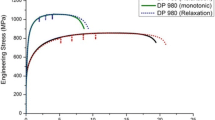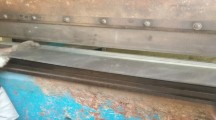Abstract
The springback is one of the key factors affecting the forming quality of 5052 aluminium alloy sections with hat profile in rotary draw bending. To study the effects of material parameters of the sections on springback, the elasto-plastic finite element bending model and unloading springback model of the process were proposed based on ABAQUS Explicit/Standard platforms. Then, the influence regularities of material parameters on springback during the process were investigated using finite element method combined with experimental and theoretical researches. The results show that springback angle and radius increase with the increase of strength factor and yield strength while decrease with the increase of Young’s modulus and strain-hardening exponent. Then, the material selection for reducing the springback of aluminium alloy section with hat profile in bending is obtained. The achievement can provide a guideline for controlling springback and selecting the material of the aluminium alloy profile rotary draw bending process.
Similar content being viewed by others
References
Zhao G, Liu Y, Yang H (2010) Effect of clearance on wrinkling of thin-walled rectangular tube in rotary draw bending process. Int J Adv Manuf Technol 50:85–92. doi:10.1007/s00170-009-2508-7
Paulsen F, Welo T (2001) Cross-sectional deformations of rectangular hollow sections in bending: part I—experiments. Int J Mech Sci 43(1):109–129. doi:10.1016/S0020-7403(99)00106-X
Lademo OG, Hopperstad OS, Pedersenc KO (2002) Modeling of plastic anisotropy in heat-treated aluminium extrusions. J Mater Process Technol 125–126:84–88. doi:10.1016/S0924-0136(02)00289-3
Cao J, Kinsey BL, Yao H, Viswanathan V, Song N (2001) Next generation stamping dies-controllability and flexibility. Robot Comput Integr Manuf 17(1):49–56. doi:10.1016/S0736-5845(00)00036-3
Leu DK (1997) A simplified approach for evaluating bendability and springback in plastic bending of anisotropic sheet metals. J Mater Process Technol 66(1–3):9–17. doi:10.1016/S0924-0136(96)02453-3
Liu J, Tang C, Ning R (2009) Plastic-formation analysis and springback calculating of thin-wall tube pure-bending. J Plast Eng 16(2):5–14 (In Chinese)
Gu R, Yang H, Zhan M, Li H (2006) Springback of thin-walled tube NC precision bending and its numerical simulation. Trans Nonferrous Metals Soc China 16(S2):s631–s638. doi:10.1016/S1003-6326(06)60268-9
Dong W, Liu Y, Yang H (2011) Sensitivity analysis of material parameters on spring-back of 3A21 aluminum alloy rectangular tube in the bending process. Metals Sci Technol 19(5):1–5 (In Chinese)
Zhu YX, Liu YL, Yang H (2014) Effect of mandrel-cores on springback and sectional deformation of rectangular H96 tube NC bending. Int J Adv Manuf Technol. doi:10.1007/s00170-014-6657-y
Zhu YX, Liu YL, Li HP, Yang H (2013) Comparison between the effects of PVC mandrel and mandrel-cores die on the forming quality of bending rectangular H96 tube. Int J Mech Sci 76:132–143. doi:10.1016/j.ijmecsci.2013.09.011
Liang J, Gao S, Teng F, Yu P, Song X (2014) Flexible 3D stretch-bending technology for aluminum profile. Int J Adv Manuf Technol 71:1939–1947. doi:10.1007/s00170-013-5590-9
Strano M (2005) Automatic tooling design for rotary draw bending of tubes. Int J Adv Manuf Technol 26(7–8):733–740. doi:10.1007/s00170-003-2055-6
Li H, Yang H, Liu K (2013) Towards an integrated robust and loop tooling design for tube bending. Int J Adv Manuf Technol 65(9–12):1303–1318. doi:10.1007/s00170-012-4258-1
Jiang ZQ, Yang H, Zhan M, Xu XD, Li GJ (2010) Coupling effects of material properties and the bending angle on the springback angle of a titanium alloy tube during numerically controlled bending. Mater Des 31:2001–2010. doi:10.1016/j.matdes.2009.10.029
Ramezani M, Ripin ZM (2010) A friction model for dry contacts during metal-forming processes. Int J Adv Manuf Technol 51:93–102. doi:10.1007/s00170-010-2608-4
Zhao GY, Liu YL, Dong CS, Yang H, Fan XG (2010) Analysis of wrinkling limit of rotary-draw bending process for thin-walled rectangular tube. J Mater Process Technol 210(9):1224–1231. doi:10.1016/j.jmatprotec.2010.03.009
Author information
Authors and Affiliations
Corresponding author
Rights and permissions
About this article
Cite this article
Zhang, R.Y., Zhao, G.Y., Guo, Z.H. et al. Effects of material parameters on springback of 5052 aluminium alloy sections with hat profile in rotary draw bending. Int J Adv Manuf Technol 80, 1067–1075 (2015). https://doi.org/10.1007/s00170-015-7056-8
Received:
Accepted:
Published:
Issue Date:
DOI: https://doi.org/10.1007/s00170-015-7056-8




